Biology MCQ For NEET With Answers Process Of Recombinant DNA Technology
Question 1. Gene recombinant technology is used for
- Vector less gene transfer into the target cell
- Vector-based gene transfer into the target cell
- The direct transfer of dna protein complex
- Liposome base direct gene transfer into the target cell
Answer: 2. Vector-based gene transfer into a target cell
In molecular cloning, the dna molecules are used as the vector to transfer the desired gene into the host genome and then replicate to express the gene. The vectors are constructed using recombinant dna technology
Question 2. A gene carried by recombinant dna is cloned when
- Its host bacterium divides by binary fission
- It is transcribed
- It is fragmented by restriction enzymes
- It is hybridized
Answer: 1. Its host bacterium divides by binary fission
- Replication of chromosomal dna in bacteria starts at a specific chromosomal site called the origin and proceeds bidirectionally until the process is complete.
- Vector dna with foreign genes is called recombinant dna. Rdna undergoes multiplication by binary fission of host cells or gene cloning process. The bacterium is divided by binary fission.
Read And Learn More: NEET Biology Multiple Choice Question And Answers
Question 3. An enzyme used to remove bacterial cell walls for genetic engineering is
- Lysozyme
- Pectinase
- Cellulase
- Lipases
Answer: 1. Lysozyme
The bacterial cell is treated with the enzyme lysozyme to remove the cell wall of peptidoglycan in bacteria for genetic engineering.
Question 4. Proteins are removed by treatment with
- Ribonuclease
- Chitinase
- Cellulase
- Protease
Answer: 4. Protease
Proteins are removed by treatment with protease.
Biology MCQ For NEET With Answers
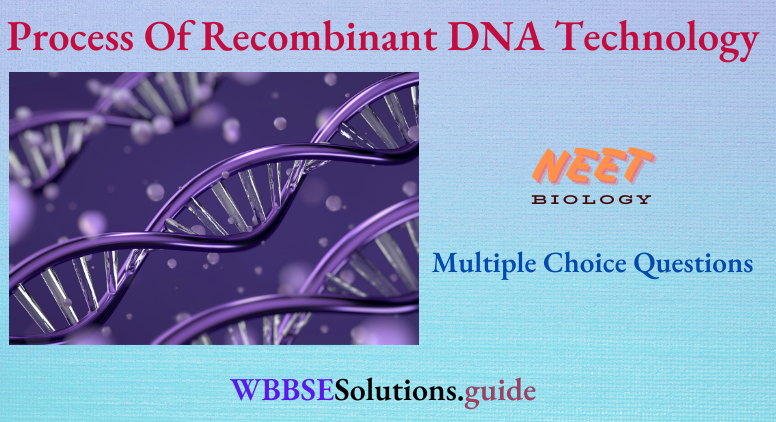
Question 5. Rna is removed by the treatment with
- Ribonuclease
- Protease
- Chitinase
- Cellulase
Answer: 1. Ribonuclease
Rna is removed by treatment with ribonuclease.
Question 6. The cell or organism from which the required gene is taken is called
- Plasmid
- Cloning vector
- Donor
- Vector
Answer: 3. Donor
The cell or organism from which the required gene is taken is called a donor. Using recombinant technology, genes from a donor cell can be transplanted into a bacterium for dna replication and protein synthesis. The kinds of cells that can be used as a donor in this technology are either yeast or bacteria or eukaryotic cells.
Question 7. Which of the following is not correctly matched for the organism and its cell wall degrading enzyme?
- Bacteria – lysozyme
- Plant cells – cellulase
- Algae – methylase
- Fungi – chitinase
Answer: 3. Algae – methylase
(3) Option (3) is not correctly matched for the organism and its cell wall degrading enzyme and can be corrected as in algae, the cell wall is made up of cellulose which can be degraded by enzyme cellulase. Rest all options are correctly matched.
Biology MCQ For NEET With Answers
Question 8. Fill up the blanks.
- Bacterial cell walls dissolve with …a…, Whereas plant cells are dissolved by the action of …b…
- Rna and proteins are removed by the treatment of …c… And …d…, respectively.
- …e… Is used to precipitate the purified dna.
- Since dna is …f… Charged, it moves towards the …g… In gel electrophoresis.
Choose the correct order.
- A–lysozyme, b–cellulase, c–deoxyribonuclease, d-lipase, e–chilled aniline, f–positively,
g–cathode - A–lysozyme, b–cellulase, c–ribonuclease, d–protease, e–chilled ethanol, f–negatively, g–anode
- A–chitinase, b–cellulase, c–ribonuclease, d–carboxylase, e–chilled benzene, f–positively, g–cathode
- A–chitinase, b–cellulase, c–deoxyribonuclease, d–amylase, e–chilled ethanol, f–negatively g–anode
Answer: 2. A–lysozyme, b–cellulase, c–ribonuclease, d–protease, e–chilled ethanol, f–negatively, g–anode
Question 9. The construction of recombinant dna involves
- Cleaving dna segments with ‘ligase’ and rejoining them with endonuclease
- Cleaving and rejoining dna segments with ‘ligase’ alone
- Cleaving and rejoining dna segments with ‘endonuclease’ alone
- Cleaving dna segments with ‘endonuclease’ and rejoining them with ‘ligase’
Answer: 4. Cleaving dna segments with ‘endonuclease’ and rejoining them with ‘ligase’
Question 10. Arrange the following steps of recombinant biotechnology in the correct order.
- Extraction of the desired gene product.
- Amplification of the gene of interest.
- Isolation of a desired dna fragment.
- Ligation of the dna fragment into a vector.
- Insertion of recombinant dna into the host.
Choose the correct order.
- 1 → 2 → 3I → 4 → 5
- 3 → 2 → 4 → 5 → 1
- 2 → 4 → 5 → 3 → 1
- 1 → 4 → 5 → 3 → 2
Answer: 2. 3 → 2 → 4 → 5 → 1
Recombinant dna technology involved the following steps
- Isolation of dna.
- Fragmentation of dna by restriction endonucleases.
- Isolation of a desired dna fragment.
- Amplification of the gene of interest.
- Ligation of the dna fragment into a vector.
- Insertion of recombinant dna into the host.
- Culturing the host cells on a suitable medium at a large scale.
- Extraction of the desired gene product.
- Downstream processing of the products as finished products ready for marketing.
- Thus, the correct order is shown in option (b).
Biology MCQ For NEET With Answers
Question 11. The assertion in recombinant dna technology, human genes are often transferred into bacteria or yeast. Reason (R) Both bacteria and yeast multiply very fast to form a huge population that expresses the desired gene.
- Both a and r are true and r is the correct explanation of a
- Both a and r are true, but r is not the correct explanation of a
- A is true, but r is false
- Both a and r are false
Answer: 1. Both a and r are true and r is the correct explanation of a
Question 12. Which of the following is used in the recombinant dna technique?
- The cell wall of the virus
- Gene which produces capsid of the virus
- Virus
- Capsid of virus
Answer: 3. Virus
In recombinant dna technology, a desired segment of dna or a gene is made to combine with the dna of an organism where it will multiply and produce its copies. Plasmids and viruses are the most commonly used cloning vectors in recombinant dna technology.
Question 13. Pcr stands for
- Polymerase chain reaction
- Primary chain reaction
- Polymerase chemical reaction
- Polymerase chain restriction
Answer: 1. Polymerase chain reaction
Pcr stands for polymerase chain reaction. It is a method for amplifying dna and was invented by Kary Mullis. It takes a single copy of a dna molecule and uses it to create millions or billions of copies of itself.
Question 14. Who discovered PCR (polymerase chain reaction)?
- Wilmut
- A Jeffreys
- Einthoven
- Kary Mullis
Answer: 4. Kary Mullis
Pcr stands for polymerase chain reaction. It is a method for amplifying dna and was invented by Ary Mullis. It takes a single copy of a dna molecule and uses it to create millions or billions of copies of itself.
Biology MCQs with answers for NEET
Question 15. Polymerase chain reaction is a technique used for
- In vivo replication of DNA
- In vivo synthesis of mRNA
- In vitro synthesis of mRNA
- In vitro replication of specific DNA
Sequence using thermostable dna polymerase
Answer: 4. In vitro replication of specific dna
The polymerase chain reaction is a technique that is used for in vitro replication of specific dna sequences using thermostable dna polymerase.
Question 16. The correct order of steps in polymerase chain reaction (PCR) is
- Extension, denaturation, annealing
- Denaturation, annealing, extension
- Denaturation, extension, annealing
- Annealing, extension, denaturation
Answer: 2. Denaturation, annealing, extension
The PCR technique is used for making multiple copies of genes (or dna) of interest in vitro. Each cycle has three steps
- Denaturation
- Annealing
- Extension
Question 17. The temperature required for various steps of polymerase chain reaction (a, b, and c ) are
- Denaturation
- Annealing
- Extension
Choose the correct option.
- A–94°c, b–40°c, c–72°c
- A–40°c, b–72°c, c–94°c
- A–72°c, b–94°c, c–40°c
- A–94°c, b–72°c, c–40°c
Answer: 1. A–94°c, b–40°c, c–72°c
Biology MCQs with answers for NEET
Question 18. Match the following columns.
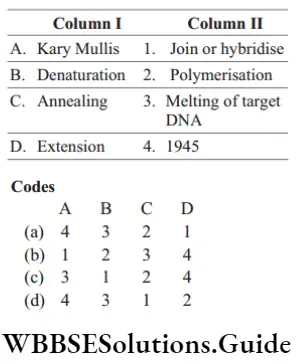
Answer: 4. A–4, b–3, c–1, d–2
Question 19. The enzyme used in polymerase chain reaction (PCR) is
- Taq polymerase
- Rna polymerase
- Ribonuclease
- Endonuclease
Answer: 1. Taq polymerase
The key ingredients of the polymerase chain reaction are taq polymerase which is the DNA polymerase enzyme isolated from a bacterium, Thermus aquaticus.
Question 20. The Taq polymerase enzyme is obtained from
- Thermus aquatics
- Thiobacillus ferroxidans
- Bacillus subtilis
- Pseudomonas putida
Answer: 1. Thermus aquaticus
The enzyme taq polymerase is a thermostable enzyme that is obtained from Thermus aquaticus.
Question 21. During the amplification of the gene using PCR, Taq polymerase is used between
- Denaturation and annealing
- Annealing and extension
- Extension and amplification
- None of the above
Answer: 2. Annealing and extension
- During the amplification of the gene in PCR, taq dna polymerase is used between extension and annealing. During the first step, the dna containing the sequence to be amplified is denatured by heating.
- This denatured dna is then annealed to an excess of the synthetic oligonucleotide primers. Then taq polymerase is used to replicate the dna segment between the sites complementary to oligonucleotide primer and extend it. Taq polymerase usually replicates dna segments of up to 2 kb.
Biology MCQs with answers for NEET
Question 22. Which is an incorrect statement?
- Taq dna polymerase is important for pcr
- Taq dna polymerase is not thermostable
- In PCR, two nucleotide primers are used
- Taq dna polymerase isolated from a bacterium, Thermus aquaticus
Answer: 2. Taq dna polymerase is not thermostable
The statement in option (2) is incorrect and can be corrected as taq dna polymerase is a thermostable enzyme, isolated from a thermophilic bacterium, Thermus aquaticus, and remain active at high temperature. Rest all options are correct statements.
Question 23. What has initiated the increase in usage of pcr (polymerase chain reaction
- Easy availability of dna template
- Availability of synthetic primers
- Availability of cheap deoxyribonucleotides
- Availability of thermostable dna polymerase
Answer: 4. Availability of thermostable dna polymerase
The availability of thermostable dna polymerase has initiated an increase in the usage of PCR. It is highly efficient and remains enzymatically active after each cycle.
Question 24. Which one is a true statement regarding dna polymerase used in PCR?
- It is used to ligate introduced dna in the recipient cell
- It serves as a selectable marker
- It is isolated from a virus
- It remains active at high temperature
Answer: 4. It remains active at high temperature
- The statement in option (4) is true regarding the DNA polymerase used in PCR as it remains active at high temperatures.
- Other statements are incorrect and can be corrected as follows dna polymerase in PCR is used to extend nucleotide sequences by replication, it does not serve as a selectable marker and it is isolated from a bacteria.
Question 25. Primers are
- Small chemically synthesized oligonucleotides of about 10-18 nucleotides that are complementary to the region of template dna
- Chemically synthesized oligonucleotides of about
10-18 nucleotides that are not complementary to the region of template dna - The double-stranded dna that needs to be amplified
- Specific sequences present on recombinant dna
Answer: 1. Small chemically synthesized oligonucleotides of about 10-18 nucleotides that are complementary to the region of template dna
NEET Biology Mcq
26. Amplification of desired dna requires
- Dna fragments to be amplified
- Primers
- dNTPs and dna polymerase
- All of the above
Answer: 4. All of the above
Gene amplification using primers can be done by polymerase chain reaction (PCR). In this reaction, multiple copies of the dna fragment are amplified in vitro using two sets of primers and the enzyme dna polymerase. Thus, option (4) is correct.
Question 27. Amplification of gene of interest by using dna polymerase may go up to
- 0.1 million times
- 1.0 million times
- 1.0 billion times
- 1.0 trillion times
Answer: 3. 1.0 billion times
- The polymerase chain reaction (PCR) provides a simple and ingenious method for the exponential amplification of specific dna sequences by in vitro dna synthesis.
- If the process of replication of dna is repeated many times (approximately 30 times), then the segment of dna can be amplified to a billion times also.
Question 28. The ideal host for the amplification of dna molecules is
- Viruses
- Plants
- Bacteria
- Animals
Answer: 3. Bacteria
- Bacteria are an ideal host for the amplification of dna because for various reasons like, their short doubling time and availability, extensive knowledge, and tools for manipulating the bacteria.
- The short doubling time is advantageous because it provides enough amounts of amplified dna in a short span of time. The fact that tools are available helps us to amplify a variety of dna molecules.
Question 29. The figure shows three steps (a, b, c) of polymerase chain reaction (PCR). Select the option giving correct identification together with what it represents.
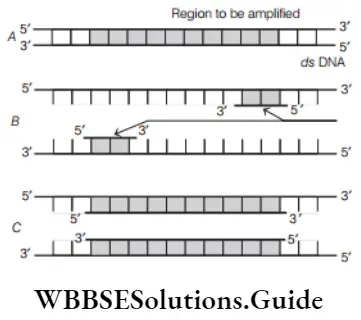
- A–denaturation at a temperature of about 98ºc separating the two dna strands
- A–denaturation at a temperature of about 50ºc
- C–extension in the presence of heat-stable dna polymerase
- A–annealing with three sets of primers
Answer: 3. C–extension in the presence of heat-stable dna polymerase
- (3) Option (3) is correct identification as the reaction mixture is first heated to a temperature between 90-98°c (commonly 94°c) that ensures dna denaturation, i.e. The separation of the two strands.
- Every single strand of the target dna then acts as a template for dna synthesis. B represents the attachment of short oligonucleotide sequences called primer by a process called annealing and Fig c represents the extension of the dna segment by the addition of nucleotides by the action of the thermostable polymerase called taq (dna) polymerase.
NEET Biology Mcq
Question 30. In the PCR technique, polymerization involves
- Synthesis of dna with the help of taq polymerase, dNTPs, and mg2+ at 72°c
- Hybridization of primers to single-stranded dna at 55°c
- Heating of double-stranded dna at 94°c
- Formation of single-stranded dna
Answer: 1. Synthesis of dna with the help of taq polymerase, dNTPs, and mg2+ at 72°c
- In the PCR technique, polymerization involves taq polymerase dna polymerase-i named after the thermophilic bacterium, Thermus aquaticus.
- Deoxynucleoside triphosphates (dNTPs) consist of four basic nucleotides, data, data, data, and dTTP, as building blocks of new dna strands. Magnesium is a required cofactor for thermostable dna polymerases. Mg 2+ in the PCR mixture stabilizes dsDNA
Question 31. Which of the following steps are catalyzed by taq polymerase in a PCR reaction?
- Denaturation of template dna
- Annealing of primers to template dna
- Extension of primer end on the template dna
- None of the above
Answer: 3. Extension of primer end on the template dna
During extension, the enzyme, Taq polymerase synthesizes the dna segment between the primers. The two primers extend towards each other in order to copy the dna segment typing between the two primers. This step requires the presence of deoxynucleoside triphosphates (dNTPs), mg 2+, and occurs at 72°c.
Question 32. Thermal cycling used in PCR technique is nothing but
- Raising the temperature of the PCR sample
- Decreasing the temperature of the PCR sample
- Alternate heating and cooling PCR sample
- Heating the PCR sample to its boiling point
Answer: 3. Alternate heating and cooling PCR sample
Thermal cycling exposes reactants to repeated cycles of heating and cooling to permit different temperature-dependent reactions specifically, dna melting and enzyme-driven dna replication.
Question 33. The most sensitive technique to detect malignant cells in non-Hodgkin’s lymphoma is
- Polymerase chain reaction
- Gene therapy
- Stem cell therapy
- None of the above
Answer: 1. Polymerase chain reaction
The most sensitive technique to detect malignant cells in non-Hodgkin’s lymphoma is a polymerase chain reaction. In recent times, PCR is being used in the detection of HIV (virus of aids) also.
Question 34. Human genetic disorders can be detected by which of the following techniques?
- Polymerase chain reaction (PCR)
- Gel electrophoresis
- Spectroscopy
- All of the above
Answer: 1. Polymerase chain reaction (PCR)
Pcr can be used to diagnose various genetic disorders like phenylketonuria, muscular dystrophy, sickle-cell anemia, hepatitis, chlamydia, and tuberculosis.
NEET Biology Mcq
Question 35. Applications of PCR include
- Detection of pathogens.
- Diagnosis of a specific mutation.
- Dna fingerprinting.
Choose the correct option.
- 1 And 2
- 1 And 3
- 2 And 3
- 1, 2 And 3
Answer: 4. 1, 2 And 3
In recent times, PCR is being used in the detection of HIV. By using PCR, phenylketonuria, muscular dystrophy, sickle-cell anemia, hepatitis, chlamydia, and tuberculosis can be diagnosed. Pcr is also used in dna fingerprinting. Thus, option (4) is correct.
Question 36. After completion of the biosynthetic stage in bioreactors, the product undergoes separation and purification processes, collectively termed as
- Transformation
- Transduction
- Downstream processing
- Upstream processing
Answer: 3. Downstream processing
After the formation of the product in the bioreactors, it undergoes some processes before a finished product is ready for marketing. The processes include the separation and purification of products, which are collectively called downstream processing.
Question 37. The process of separation and purification of expressed protein before marketing is called
- Upstream processing
- Downstream processing
- Bioprocessing
- Postproduction processing
Answer: 2. Downstream processing
- The down-streaming process helps in the recovery and purification of biosynthetic products. It is mainly used during the large-scale production of metabolites.
- The steps included in downstream processing are removal of insoluble, isolation of product, purification of product, and product polishing.
Question 38. Downstream process includes
- Formation of the product with suitable preservatives.
- Purification of the product.
- Quality control testing and clinical trials in the case of drugs.
- Separation of the product from the reactor.
Which of the statement given above are correct?
- 1, 2 And 3
- 1, 2 And 4
- 2, 3 And 4
- 1, 2, 3 And 4
Answer: 4. 1, 2, 3 And 4
- All given statements are correct about the downstream process. down streaming process helps in the recovery and purification of the biosynthetic product.
- It is mainly used during the large-scale production of metabolites. The steps included in downstream processing are removal of insoluble, isolation of product, purification of product, and product polishing.
Question 39. A bioreactor is
- Hybridoma
- A culture containing radioactive isotopes
- Culture for the synthesis of new chemicals
- Fermentation tank
Answer: 4. Fermentation tank
The bioreactor is a simple and widely used fermenter design that consists of a cylindrical vessel with a stirrer. The design has been used extensively in all microbial fermentations and has been the main system used in yeast fermentation in the brewing industry for countries.
Question 40. Which of the following is not a component of downstream processing?
- Separation
- Purification
- Preservation
- Expression
Answer: 4. Expression
Downstream processing is the recovery of biological products which includes extraction, separation, purification, and preservation of the biotechnological products. The product is formulated with suitable preservatives. So, expression is not a component of downstream processing.
Question 41. Bioreactors are useful in
- Separation and purification of a product
- Processing of large volumes of culture
- Microinjection
- Isolation of genetic material
- Amplification of genes
Answer: 2. Processing of large volumes of culture
- Bioreactors are large culture vessels in which raw materials are biologically converted into specific products, using microbial plant, animal, or human cells or their enzymes.
- A bioreactor provides the optimal condition for achieving the desired product by providing optimum growth conditions (temperature, ph, substrate, salts, vitamins, oxygen, etc.) And helps in processing large volumes (100-1000 l) of culture.
Question 42. Consider the following statements about bioreactors.
- They provide optimal conditions for temperature, ph, substrate, salt, vitamin, and oxygen, required for obtaining a desired product.
- Well suited for large-scale production of microorganisms under aseptic conditions for a number of days.
Choose the correct option.
- Statement 1 is correct, but 2 is incorrect
- Statement 1 is incorrect, but 2 is correct
- Both statements 1 and 2 are correct
- Both statements 1 and 2 are incorrect
Answer: 3. Both statements 1 and 2 are correct
- Both statements 1 and 2 are correct as bioreactors are large volume vessels (100-1000 l) in which raw materials are biologically converted into specific products on a large scale, under aseptic conditions.
- They provide all the optimal conditions for achieving the desired product by providing optimal growth conditions like temperature, ph, substrate, salts, vitamins, and oxygen.
Question 43. The components of a bioreactor are
- An agitator system
- An oxygen delivery system
- Foam control system
- Temperature control system
- Ph control system
- Sampling ports to withdraw cultures periodically
Choose the correct option.
- 1, 2, 3, 4 And 5
- 2, 4, 5 And 6
- 1, 2, 3, 4 And 6
- 1, 2, 3, 4, 5 And 6
Answer: 4. 1, 2, 3, 4, 5 And 6
The components of a bioreactor include an agitator system, an oxygen delivery system, a foam control system, a temperature control system, a ph control system, and sampling ports to withdraw culture periodically. Thus, option (4) is correct.
Question 44. Identify the correct match for the given diagram.
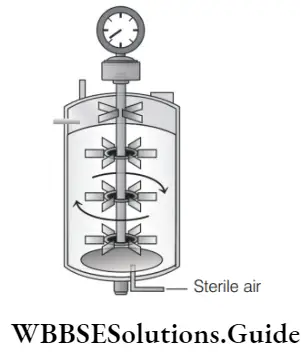
Apparatus – functions
- Gene gun – vector less direct gene transfer
- Electrophoresis – differential migration of dna fragments
- Bioreactor – raw materials are biologically converted into specific products
- Respirometer – finding out the rate of respiration
Answer: 4. Bioreactor – raw materials are biologically converted into specific products
(3) Option (3) is the correct match. The given diagram is of a bioreactor. These are vessels of large volumes (100-1000 l) in which raw materials are biologically converted into specific products.
Question 45. Consider the following statements.
- Bioreactors are large vessels in which raw materials are biologically converted into specific products.
- Stirring type is one of the most commonly used bioreactors.
- On a small scale, shake flasks are used for growing and mixing the desired materials in the laboratory.
- Large-scale production of the desired biotechnological products is done by using ‘bioreactors’.
Choose the option containing
Correct statements.
- 1 And 2
- 1 And 3
- 1, 2 And 3
- 1, 2, 3 And 4
Answer: 4. 1, 2, 3 And 4
- All given statements are correct as small-volume cultures are usually employed in laboratories for research and production of fewer quantities of products, for example. In shake flasks. However, large-scale production of the products is carried out in ‘bioreactors’.
- These large vessels (having a volume of 100 to 1000 l) are used for the biological conversion of raw materials into specific products. The most commonly used bioreactors are of stirring type.
Question 46. Which one of the following equipment is essentially required for growing microbes on a large scale, for the industrial production of enzymes?
- BOD incubator
- Sludge digester
- Industrial oven
- Bioreactor
Answer: 4. Bioreactor
Question 47. The simple stirred-tank bioreactor is given below. Identify a, b, and d
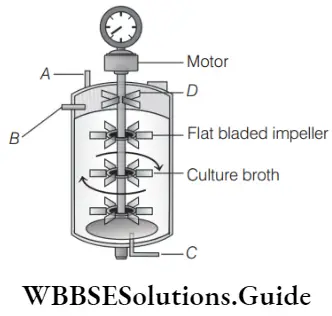
Choose the correct option.
- A–acid/base for ph control, b–steam for sterilization, c–sterile air, d–foam breaker
- A–foam breaker, b–steam for sterilization, c–sterile air, d–acid/ base for ph control
- A–acid/base for ph control, b–vacuum chamber, c–steam for sterilization, d–sterile air
- A–steam for sterilization, b–foam breaker, c–sterile air, d–acid/base for ph control
Answer: 1. A–acid/base for ph control, b–steam for sterilization, c–sterile air, d–foam breaker
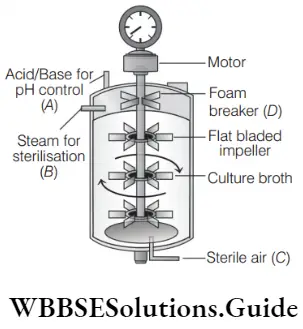
Question 48. Stirred-tank bioreactors have been designed for
- Purification of the product
- Addition of preservatives to the product
- Availability of oxygen throughout the process
- Ensuring anaerobic conditions in the culture vessel
Answer: 3. Availability of oxygen throughout the process
- A stirred-tank bioreactor is usually cylindrical and provided with rotating shafts and blades to facilitate the mixing of the reaction contents.
- The stirrer provides the facility of mixing the contents as well as the availability of oxygen throughout the process. Alternatively, air can be bubbled through the reactor.
Question 49. Stirrer is provided with a rotating shaft and blades for
- Proper foam control
- Proper mixing
- Control of temperature
- Control of ph
Answer: 2. Proper mixing
- A stirred-tank bioreactor is usually cylindrical and provided with rotating shafts and blades to facilitate the mixing of the reaction contents.
- The stirrer provides the facility of mixing the contents as well as the availability of oxygen throughout the process. Alternatively, air can be bubbled through the reactor.
Question 50. What is the advantage of stirred-tank bioreactors over shake flasks?
- Provides high temperature and pH
- Provides better aeration and mixing properties
- Does not allow the entry of co 2
- Easier to operate
Answer: 2. Provides better aeration and mixing properties
A stirred-tank bioreactor is more advantageous over shake flasks. It has an agitator system to mix the contents properly, an oxygen delivery system to ensure the availability of oxygen, a foam control system, a temperature control system, a ph control system, and a sampling port to withdraw the small volumes of the culture periodically. Thus, it provides better aeration and mixing properties.
Question 51. Identify the correct statements with respect to a bioreactor.
- It can process a small volume of culture.
- It provides optimum temperature, ph, salt, vitamins, and oxygen.
- The sparged stirred-tank bioreactor is a stirred-type reactor in which air is bubbled.
Choose the correct option.
- 1 And 2
- 1 And 3
- 2 And 3
- None of the above
Answer: 3. 2 And 3
Statements 2 and 3 are correct. Statement 1 is incorrect and can be corrected as bioreactors can process culture in large volumes.
Question 52. Microorganisms can be grown in bioreactors by Odisha
- Support growth system
- Agitated growth system
- Suspended growth system
- Both (1) and (3)
Answer: 4. Both (1) and (3)
Microorganisms can be grown in the bioreactors by a support growth system and a suspended growth system. Thus, option (4) is correct.
Question 53. Which of the following would have the highest oxygen transfer rate characteristics?
- A sparged stirred tank bioreactor being stirred at 200 pm
- A non-sparged stirred tank bioreactor being stirred at 200 pm
- A shake flask being mixed at 200 pm
- All of the above would have equivalent oxygen transfer rate characteristics
Answer: 1. A sparged stirred tank bioreactor being stirred at 200 pm
A sparged stirred-tank bioreactor being stirred at 200 rpm, overcome the limitation of bulk mixing. The air bubble produced in the sparger increases the surface area for the transfer of oxygen.
Question 54. Match the following techniques or instruments with their usage.
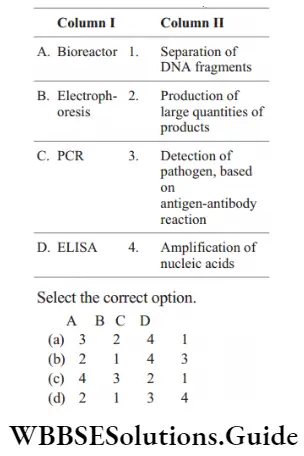
Answer: 1. A-2, b-1, c-4, d-3

